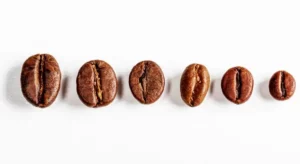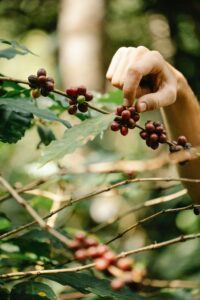Last updated on May 20th, 2024 at 11:50
Where do coffee beans come from is a question that we often wonder and perhaps ask ourselves. This article details where Arabica beans, robusta beans, and even where decaffeinated coffee beans come from.
If you are in a rush, coffee beans come from the coffee plant which can be traced back to Ethiopia.
Keep reading to find out more about the origins of coffee, and the climate in which they thrive.
Where Do Coffee Beans Come From? – What Are The Origins Of Coffee?
Table Of Contents
- 1 Where Do Coffee Beans Come From? – What Are The Origins Of Coffee?
- 2 Do Different Coffee Plants Produce Different Coffee Beans?
- 3 How Many Different Types Of Coffee Beans Are There?
- 4 Where Do Arabica Coffee Beans Come From?
- 5 Where Do Robusta Coffee Beans Come From?
- 6 Do Coffee Beans Come From Cherries? Is Coffee A Berry Or Cherry?
- 7 What About Decaffeinated Coffee Beans? Where Do Decaffeinated Coffee Beans Come From
- 8 Frequently Asked Questions About Where Do Coffee Beans Come From
- 9 Final Thoughts – Where Do Coffee Beans Come From?
The discovery of coffee can be traced back over several centuries to Ethiopia, where, rather surprisingly, coffee is still grown today. They can be traced to the Kaffa region, where the name coffee gets its name.
As the legend has it, a goat herder, Kaldi noticed that his goats were stimulated when they ate the ripe berries from a certain bush, and that was the start of coffee.
From very humble beginnings to the second most traded commodity in the world behind oil!
The first use of coffee as a beverage in recorded history is credited to Yemen in the 15th century.
Coffee’s popularity is such that it is grown in more than 70 countries across what is known as the coffee belt.
The biggest surprise to most coffee lovers is when they find out that coffee is not native to Brazil nor Vietnam, the two largest producers. It was brought there by the French and Portuguese Colonialists as a cash crop.
Coffee plants, often referred to as coffee trees, coffee bushes and shrubs need a specific environment in which they thrive.
- 18C to 21C (64F to 70F).
- 1,800 feet to 6,300 feet (548M to 1920M).
- 59 to 118 inches of annual rainfall.
- No more than 3 hrs of daily sunshine.
These specifications limit the cultivation to the areas between the Tropic of Cancer and The Tropic of Capricorn and stretches across the world.
In places where coffee farmers can’t limit the sunshine by planting on an East facing slope they can use the technique of shade growing their coffee.

Read: Does coffee grow on trees?
Do Different Coffee Plants Produce Different Coffee Beans?
Yes, there are 120+ different varieties of coffee plants with each one producing a slightly different type of coffee bean. Despite that fact, only 2 main coffee beans are used. These two beans, Arabica coffee and Robusta coffee beans, account for 90% of all coffee sold in the world.
Arabica beans (Coffea arabica), due to being more tasty and having more flavor, account for 60% of all coffee sold. Robust (Coffea Canephora) accounts for 30%.
The remaining 10% can be accredited to Liberica coffee beans which dominate the Malay Peninsula and account for 7% of global sales and Excelsa coffee beans 3%. The remaining 116 or so varieties are almost never used.
It is very common for different coffee beans to be used in a blend for a variety of different reasons, namely to improve the flavor and increase the caffeine content.
Coffee beans are usually oval in shape and have a pronounced center crease which are larger in the arabica variety. Arabica coffee plants can be dated back to 1,000 BC and are loved for their complex and vibrant flavors.
Arabica coffee is much loved for their sweeter softer flavors that often have tones of chocolate, nuts and fruits.
Arabica beans need more care and attention when growing as they are more susceptible to disease and more delicate. Because of this they are a little more expensive than a Robusta coffee bean.
An Arabica bean will normally need an altitude of 500 to 2500M and are predominantly grown in Latin America with Brazil the largest producer.
Robusta coffee bean is much easier to cultivate and more resistant to disease like coffee rust and dominates Asia and Africa with Vietnam, the leading producer of Robusta coffee.
Robusta coffee is usually grown at altitudes of less than 1000m and are able to produce fruits quicker than an Arabica and grow more cherries per tree than an Arabica.
Robusta stands out due to their elevated caffeine content and are often used in espresso blends to boost the caffeine content of the blend.
A robusta bean is lighter in color, with a less pronounced center crease. They are also smaller and rounder, more circular in shape.
How Many Different Types Of Coffee Beans Are There?
As mentioned there are 120+ species of coffee with only 4 used to make coffee with 90% of all coffee sold being Arabica and Robusta with Arabica the preferred type due to having a better flavor profile with notes of nuts, caramel and chocolate.
Arabica coffee plants unfortunately do produce a coffee that is more acidic. You can easily tell an Arabica bean due to being more oval in shape and more shaped like a typical bean.
Robusta beans produce a bold intense coffee with a significantly higher caffeine kick with 2.2x to 2.7x more caffeine typically. They also produce an earthy, more bitter taste.

Where Do Arabica Coffee Beans Come From?
The Arabica coffee beans come from the cherries of the Coffea Arabica Plant that originates in Ethiopia, which is well known and well respected by coffee lovers as being the home of coffee.
Arabica coffee beans represent 60% of global coffee production.
What Is So Special About Arabica Coffee?
Arabica coffee is special as they have 60% more lipids and almost double the sugar content of Robusta coffee. More lipids mean more flavor, aroma and a deeper body.
The increased amount of sugar means they are less bitter and have a better, cleaner mouthfeel.
Where Do Robusta Coffee Beans Come From?
Robusta coffee, Coffea Canephora plant is predominantly grown in Asia and Africa with Vietnam dominating the Robusta coffee market. Although many claim that Vietnam exclusively grows this variety, it is not true, the Asian nation does produce Arabica coffee in limited quantities in the Central Highlands in the Da Lat area.
Despite being less flavorful and sold at a reduced price, Robusta coffee is much easier to farm due to being more resistant to disease. Robusta coffee is considered as lower quality coffee, but that does not stop Vietnam from being one of the stand-out coffee cultures in the world.
What the beans lack in flavor does not stop the Vietnamese from being creative with the staple product. They make fab tasty and healthy coffee smoothies by adding a shot of coffee to a banana, strawberry durian and Avocado smoothie for a healthy caffeine hit – and even yoghurt and there is their outstanding Ca Phe Trung, egg coffee and iced coconut coffee.
They have taken what they have and make amazing coffee that stands out! If you really want to know what to do with Robusta coffee, take a trip to Vietnam and learn! At Latte Love Brew we encourage you to experiment and make different coffee beverages from different cultures. I spent 3 years in Vietnam, naturally I encourage you try some of their unique coffee creations.
Do Coffee Beans Come From Cherries? Is Coffee A Berry Or Cherry?
Ok, we call coffee beans, beans, but they are not actually beans, they are actually the seeds or pips of a….
wait!
Berry.
Despite commonly being called a cherry (and it is a term I use, guilty as charged your honor!) those bright red “cherries” are actually berries. So it’s not a bean, it’s a seed that is from the coffee berry.
The little coffee fruits, the berries have an outer husk or skin which covers an inner layer of pulp. In the center are two coffee seeds.
On occasion, rare occasions, a coffee berry will produce a berry that has just one seed. These are known as peaberries. Due to not having a second bean to share the flavor compounds and nutrients with, it produces a more nutritious and more delicious coffee.
If you see them, particularly Tanzanian Peaberry coffee, which is known as being the best in the world.

What About Decaffeinated Coffee Beans? Where Do Decaffeinated Coffee Beans Come From
There is only one coffee bean that grows and is naturally caffeine free, the Coffea Charrieriana which is grown in Cameroon.
However,
and very sadly this genus of coffee is not where commercially available decaffeinated coffee comes from. The term “caffeine free” and “decaffeinated” should tell you something, that the beans are not caffeine free, and have the caffeine removed to become decaffeinated.
There are four main processes used to remove the caffeine from coffee beans.
- Direct Solvent Process.
- Indirect Solvent Process.
- Carbon Dioxide Process.
- Swiss Water Process.
The best and most natural of them is the Swiss water process, which removes almost all the caffeine, leaving only a negligible amount of caffeine in the beans, much less than the other processes with no chemicals used.
Frequently Asked Questions About Where Do Coffee Beans Come From
Where Do Coffee Beans Originate?
Coffee beans origins can be traced to the ancient coffee forest on the Ethiopian plateau and the coffee forest.
As the legend goes, Kaldi, the goat herder, first discovered the potential of coffee beans after his goats became energized after eating them.
What Tree Do Coffee Beans Come From?
Coffee berries are harvested from the coffee plant. The botanical name of the plant is Coffea. Everyone in the world knows what a coffee bean looks like but may not recognize a coffee plant or even know that the bean is not actually a bean – it’s the seed of a coffee cherry.
Where Are Starbucks Coffee Beans From?
Starbucks sources their Arabica coffee from Latin America, Asia Pacific and Africa. It is not known which countries exactly or the precise Provence within the coffee growing countries or the ratios in their blends – this kind of information is a trade secret.
On some of their specialty coffee, they will name the country but not the exact details.
What Are The 4 Types Of Coffee?
There are 4 different types of coffee beans, which are:
- Arabica coffee.
- Robusta coffee.
- Liberica Coffee.
- Excelsa Coffee.
All 4 coffee beans look slightly different and have very different flavor profiles.
How Many Years Does It Take A Coffee Bean To Become A Tree?
The coffee tree grows for a seed that is planted and takes from 4 to 8 weeks to develop into a seedling and then, after 3 to 5 years depending on the variety, will produce the first fruits, their first cherries. After a further 3 years, the tree will be full of its first fruit and ready to harvest.
What Is The Rarest Type Of Coffee?
The rarest coffee in the world is black ivory coffee. This is the rarest coffee with only 215 Kg (474 pounds) produced per year and is sold only to 5-star hotels.
There is a very small amount that you can buy from their website, but it is very difficult to get hold of it due to the exclusivity.
Final Thoughts – Where Do Coffee Beans Come From?
Now you know the answer and the legendary story of where do coffee beans come from and what coffee beans are best and why.
Also, you picked up some excellent tips about what to do when life hands you…well, a bag of robusta coffee beans! Do what the Vietnamese do and make great coffee and get creative with fruity inventions like orange coffee, coconut coffee, banana coffee and more.
Join our active, fun, informative coffee community on Facebook/Meta and take part by sharing your memes, jokes, recipes and coffee creations.

![Where Do Coffee Beans Come From [The Definitive Answer]](https://lattelovebrew.com/wp-content/uploads/2022/12/Where-Do-Coffee-Beans-Come-From-The-Definitive-Answer-1024x576.jpg)





